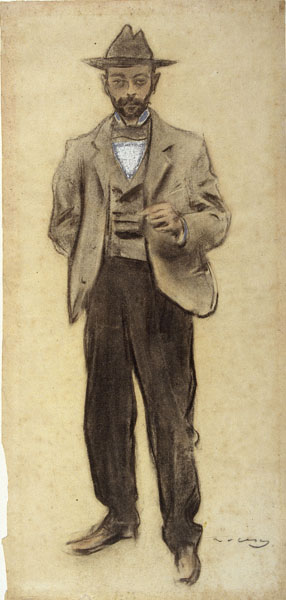Manolo (sculptor) facts for kids
Manuel Martinez Hugué, known simply as Manolo, was a famous Spanish sculptor from Catalonia. He was born on April 29, 1872, and passed away on November 17, 1945. Manolo was part of an art movement called noucentisme. Even though he was a friend of the well-known artist Pablo Picasso, Manolo's sculptures looked more like the work of Aristide Maillol.
Contents
Biography
Early Life and Time in Paris
Manolo was born in Barcelona in 1872. His father was a general who left to fight in the Ten Years' War. Manolo's mother passed away when he was still young.
He became friends with Pablo Picasso and was part of the artistic group at the famous cafe, 4 Gats. From 1900 to 1909, Manolo lived in Paris. There, he helped welcome Picasso and introduced him to other artists in the city. Manolo was one of Picasso's closest friends at the Bateau Lavoir, along with artists like Guillaume Apollinaire and Max Jacob.
While in Paris, Manolo mainly created small sculptures and jewelry. This helped him earn a living. He married Jeanne de Rochette, also known as Totote, who worked at a bar near Montmartre. They got married around 1910. They adopted a daughter named Rosa Jordana, or Rosita. Both Rosita and Totote were later drawn by Picasso in 1954.
Moving to Céret
In 1910, Manolo traveled to Céret with his friends Frank Burty Haviland and Déodat de Séverac. Soon, many Cubist artists, including Picasso, Georges Braque, Max Jacob, and Juan Gris, also came to Céret for different lengths of time. Manolo settled in a cloister (a covered walkway) that Burty Haviland had bought. Picasso even took over the first floor of this building.
In Céret, Manolo began working on larger sculptures. These included the Monument for Déodat de Séverac in 1923 and a Monument for the Dead in 1924. However, he faced health problems, especially arthritis. This meant he had to reduce the amount of work he could do.
Later Life and Exhibitions
Manolo stayed in Céret until 1928. Then, he moved back to Spain, to the spa town of Caldes de Montbui. This was his grandmother's hometown. He hoped the spa waters would help with his arthritis.
From 1912 to 1933, Manolo received support from Daniel-Henry Kahnweiler, an art dealer. Manolo also took part in the 1913 Armory Show, a very important art exhibition. After that, he had many group and solo art shows. He was even made a member of the Reial Acadèmia Catalana de Belles Arts de Sant Jordi, a royal art academy.
In 1932, Manolo had a major solo exhibition at the Grand Palais in Paris.
Manolo passed away in Caldes de Montbui on November 17, 1945. After his death, his wife Totote lived with the Comte and Comtesse de Lazerme, who were wealthy art supporters from Perpignan. She also lived at the Manolo house in Caldes until she died in 1971.
Manolo's house in Caldes has now become the Thermalia Museum. It holds the Manolo Fund, which includes his artworks and information about him. It also has about 100 works by Picasso.
Manolo Hugué's personal papers are kept safe at the Biblioteca de Catalunya (Library of Catalonia).
In Popular Fiction
In the 2013 Spanish film La banda Picasso, the character of Manolo is played by the actor Jordi Vilches.
See also
 In Spanish: Manuel Hugué para niños
In Spanish: Manuel Hugué para niños


